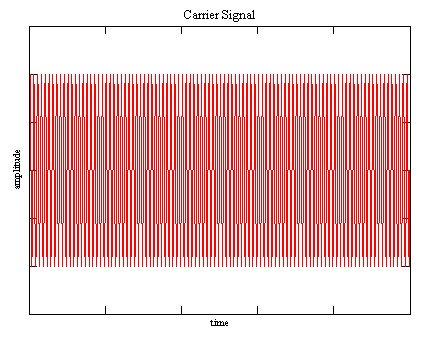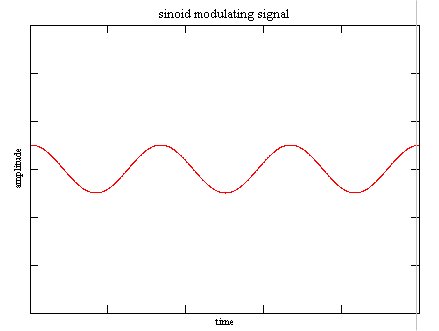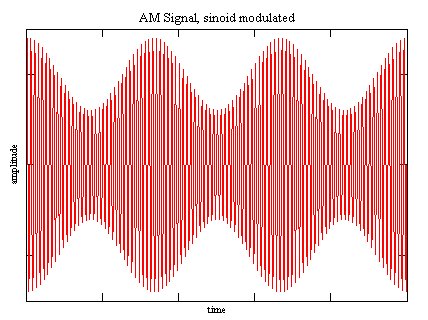Amplitude modulation: Difference between revisions
(please correct this) |
(Wikification. Fix crappy English. Please put thoughts about the article's development on the talk page.) |
||
| (17 intermediate revisions by 5 users not shown) | |||
| Line 1: | Line 1: | ||
'''Amplitude modulation''' ('''AM''') is a [[modulation scheme]], notably used in AM radio. |
|||
==What is AM?== |
|||
Amplitude Modulation is the done by modulating the Amplitude of an sinoid Carrier signal. |
|||
The Carrier Signal has usually a higher [[Frequency]] than the modulating signal. |
|||
| ⚫ | |||
An amplitude transceiver modulates the amplitude of an sinusoid carrier signal using the incoming signal. The carrier signal is sinusoid with a fixed [[Frequency]], usually much higher than the highest frequency occurring in the spectrum of the modulating signal. |
|||
Picture1: Carrier Signal in time domain |
|||
Picture2: Carrier Signal in frequency domain |
|||
| ⚫ | |||
Picture4: Modulating Signal in frequency domain |
|||
== Mathematical setting == |
|||
Picture5: Modulated Signal |
|||
Base for transmission is a sinusoid carrier signal with continuous carrier frequency <math>f_c</math>: |
|||
: <math>\omega_c := 2 \pi f_c</math> |
|||
This is modulated by the incoming signal, here modeled by a simple sine with frequency <math>f_m</math>: |
|||
| ⚫ | |||
: <math>\omega_m := 2 \pi f_m</math> |
|||
*DSSC, double side band supressed carrier |
|||
| ⚫ | |||
The actual signal coming out of the AM modulator is simply the product of both functions <math>\omega_c \cdot \omega_m</math>. Evaluating this in detail leads to the expression: |
|||
| ⚫ | |||
: <math>u_{AM}(t) = U_c \cdot cos(\omega_c \ t) \cdot [1 + m \cdot cos(\omega_m \ t)]</math> |
|||
*[[Quadrature_Amplitude_Modulation|QAM]] |
|||
where <math>U_c</math> is the modulation amplitude and <math>m</math> the modulation index. |
|||
[[File:AM mathematical desc.jpg|Description]] |
|||
The first formula describes what happens in time domain. It's basically multiplying of two cosine signals leading to the time domain picture in the example below. |
|||
The second formula describes the frequency response, the frequency spectrum consists of three spectrum lines at each time, t. The first term is the carrier, for sure the carrier is in the spectrum, the second and third terms describe two spectrum lines around the carrier, and their amplitude is dependent on the modulation index, m. As the modulating signal varies the lines around the carrier frequency are varying. |
|||
| ⚫ | |||
{| |
|||
| [[File:AM picture1.jpg|frame|Carrier signal in time domain]] |
|||
| [[File:AM picture4.jpg|frame|Carrier signal in frequency domain (to be added)]] |
|||
|- |
|||
| ⚫ | |||
| [[File:AM picture5.jpg|frame|Modulating signal in frequency domain (to be added)]] |
|||
|- |
|||
| [[File:AM picture3.jpg|frame|AM signal]] |
|||
| [[File:AM picture6.jpg|frame|AM signal in frequency domain (to be added)]] |
|||
|} |
|||
| ⚫ | |||
* Double sideband suppressed carrier (DSSC) |
|||
| ⚫ | |||
| ⚫ | |||
* [[Quadrature Amplitude Modulation]] (QAM) (used in digital TV applications) |
|||
== Acquired bandwidth == |
|||
An AM signal shows up as a single peak in the frequency spectrum. |
|||
== Noise sensitivity == |
|||
Echoes, multipath signaling, atmospheric and meteorologic phenomenons like lightings and electrostatic discharges contribute noise that simply gets added to the transmitted signal. Most other Modulation Schemes are less sensitive to noise. |
|||
== External links == |
|||
* [[Wikipedia:Amplitude modulation]] at Wikipedia |
|||
* [[Wikipedia:History of radio|History of radio]] at Wikipedia |
|||
[[Category:Technology]] |
|||
Latest revision as of 07:21, 26 December 2016
Amplitude modulation (AM) is a modulation scheme, notably used in AM radio.
An amplitude transceiver modulates the amplitude of an sinusoid carrier signal using the incoming signal. The carrier signal is sinusoid with a fixed Frequency, usually much higher than the highest frequency occurring in the spectrum of the modulating signal.
Mathematical setting
Base for transmission is a sinusoid carrier signal with continuous carrier frequency <math>f_c</math>:
- <math>\omega_c := 2 \pi f_c</math>
This is modulated by the incoming signal, here modeled by a simple sine with frequency <math>f_m</math>:
- <math>\omega_m := 2 \pi f_m</math>
The actual signal coming out of the AM modulator is simply the product of both functions <math>\omega_c \cdot \omega_m</math>. Evaluating this in detail leads to the expression:
- <math>u_{AM}(t) = U_c \cdot cos(\omega_c \ t) \cdot [1 + m \cdot cos(\omega_m \ t)]</math>
where <math>U_c</math> is the modulation amplitude and <math>m</math> the modulation index.
The first formula describes what happens in time domain. It's basically multiplying of two cosine signals leading to the time domain picture in the example below.
The second formula describes the frequency response, the frequency spectrum consists of three spectrum lines at each time, t. The first term is the carrier, for sure the carrier is in the spectrum, the second and third terms describe two spectrum lines around the carrier, and their amplitude is dependent on the modulation index, m. As the modulating signal varies the lines around the carrier frequency are varying.
Example
File:AM picture4.jpg Carrier signal in frequency domain (to be added) | |
File:AM picture5.jpg Modulating signal in frequency domain (to be added) | |
File:AM picture6.jpg AM signal in frequency domain (to be added) |
Special kinds
- Double sideband suppressed carrier (DSSC)
- Single side band (SSB)
- Vestigial side band modulation (VSB) (used in digital TV applications)
- Quadrature Amplitude Modulation (QAM) (used in digital TV applications)
Acquired bandwidth
An AM signal shows up as a single peak in the frequency spectrum.
Noise sensitivity
Echoes, multipath signaling, atmospheric and meteorologic phenomenons like lightings and electrostatic discharges contribute noise that simply gets added to the transmitted signal. Most other Modulation Schemes are less sensitive to noise.
External links
- Wikipedia:Amplitude modulation at Wikipedia
- History of radio at Wikipedia



